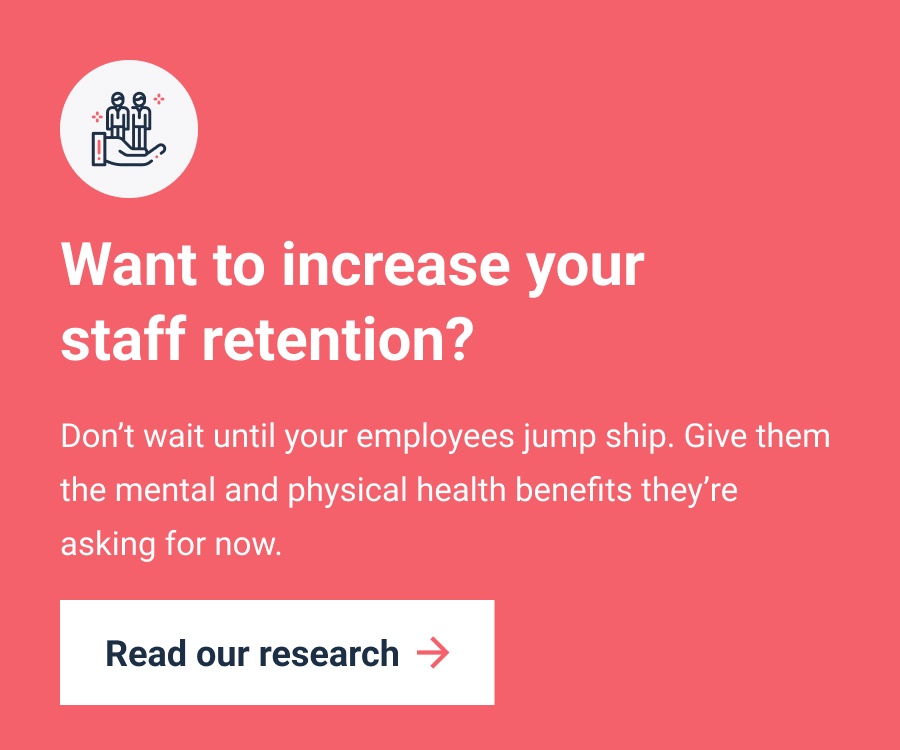Did you know that 95 percent of new year's resolutions are fitness related, but after just three months, only ten percent of people think their resolution will last?
We’ve all been there. You make a resolution to walk more or take up running with the best of intentions, but for some reason, it just doesn’t stick. Often, this is because it’s hard to tackle resolutions alone.
But, there’s power in community. Facilitating fitness at work can help bring your teams together and improve overall employee wellbeing.
So, let’s explore some of the ways you can encourage fitness in your workplace.
Enhancing wellbeing through physical activity
‘If exercise could be packed into a pill, it would be the single most widely prescribed and beneficial medicine in the nation.’ - Dr Robert Butler, founder of the US National Institute on Ageing
For some, the mention of ‘physical activity’ conjures up images of school gym sessions and endless marathons. But it doesn’t have to be like that. There are many ways to increase your activity levels - such as walking, running, cycling, or playing sports.
But what are the benefits? Well, it can improve your physical and mental health by:
- Improving your mood
- Increasing your self-esteem
- Reducing stress
- Boosting your cognitive health
And there’s a preventative element at play here as well. Regular physical activity can reduce your risk of major illnesses, such as coronary heart disease, stroke, type 2 diabetes, and cancer. It can also lower your risk of early death by up to 30 percent. These benefits carry over into mental health as well. There’s a 20-30 percent lower risk of depression and dementia for adults who partake in daily physical exercise.
But, don’t think you need to be in the gym every day. Even the smallest increase in activity can have a positive impact. In fact, something as simple as a brisk 10-minute walk can improve your mood.
How to get everyone moving: 5 ways to promote fitness at work
Our busy modern schedules make it difficult to find time to exercise with others. That’s why as an employer, you can help your employees get more exercise by working it into your culture.
Not sure where to start? Here are a few ideas to get you going:
1. Introduce a cycle/walk to work scheme
Cycling or walking to work offers many benefits, both for employers and employees. First and foremost, it introduces physical activity in a time that’s usually taken up by commuting. This means your employees receive all the health benefits of physical exercise without having to fit something new into their schedules.
Cycling and walking to work also saves money. Your employees cut down on their fuel bills or the cost of train tickets, and cut out the expense of purchasing a bicycle. Employers can save money by getting more from their healthy employees, as well as saving on National Insurance contributions.
2. Create your own sports team or running club
Forty-five percent of men and 43 percent of women suggested that playing football, netball, or tennis together with colleagues would increase morale and productivity. This is according to a study by Hudson.
We’re social creatures and like to feel like we’re part of the team. Setting up a sports team or running club in your organisation will not only improve your employees’ fitness, but add a social element. This can increase productivity and helps to forge strong bonds between colleagues.
3. Organise yoga sessions in the mornings
Yoga is one of the mostly widely practiced forms of exercise in the world, and its popularity isn’t showing any signs of slowing down. Indeed, the number of people doing yoga grew by 63 percent between 2010 and 2021. When you look at the benefits, it’s easy to see why.
In a recent survey of people who practice yoga:
- 86 percent reported a reduction in stress.
- 59 percent reported an improvement in sleep quality and quantity.
- 86 percent reported an overall improved sense of mental wellness and clarity.
You’re sure to have a few yogis in your workplace, and probably a few more who are willing to give it a go. Setting up a morning yoga club will help your employees get the most out of this ancient art before starting their day. And, if a full session is a little daunting, they can always try desk yoga.
4. Run a monthly step-count challenge for charity
We all love a challenge, and a bit of competition can be a strong motivator.
One of the most popular ways to pit your employees against each other in a positive way is to run a step-count challenge. Organise a month-long event and ask participating employees to keep track of their step count. At the end of the month, the employee with the most steps logged wins.
5. Support your workforce with a holistic wellbeing app
A well-designed wellbeing app encourages your employees to take control of their fitness on their terms and on their timescale. Take Symbio as an example. Our holistic wellbeing app provides your employees with personalised, clinically validated content to help them improve their physical and mental health. This includes tailored advice related to physical exercise.
It’s worth noting here that you should always be mindful of your disabled workers and those who may have invisible chronic illnesses. Not all of the ideas we’ve listed will work for everyone, but you can of course adjust them. A good wellbeing app should provide resources and exercises that are right for each individual's ability level.
Keep the momentum going
Getting these ideas off the ground might prove easy, but keeping them going is the real challenge.
To keep up your momentum and make sure your efforts aren’t going to waste, work on some ways to maintain motivation. A great way to do this is to share fitness tips and motivation on a dedicated Slack channel or in a monthly email newsletter.
In the end, it’s all about improving physical fitness for the good of your employees’ wellbeing. During your wellbeing initiatives or surveys, communicate the importance of physical fitness and let everyone know that it’s an area you care about. That way, you’ll build a culture around healthy physical habits and keep the benefits ticking over.
If you’re eager to find out more ways to improve your employees’ wellbeing, head over to our resources page.





